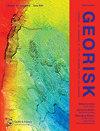2D Numerical Simulation of Floods in Ebro River and Analysis of Boundary Conditions to Model the Mequinenza Reservoir Dam
IF 4.8
3区 工程技术
Q1 ENGINEERING, GEOLOGICAL
Georisk-Assessment and Management of Risk for Engineered Systems and Geohazards
Pub Date : 2023-04-27
DOI:10.3390/geohazards4020009
引用次数: 2
Abstract
The computational simulation of rivers is a useful tool that can be applied in a wide range of situations from providing real time alerts to the design of future mitigation plans. However, for all the applications, there are two important requirements when modeling river behavior: accuracy and reasonable computational times. This target has led to recent developments in numerical models based on the full two-dimensional (2D) shallow water equations (SWE). This work presents a GPU accelerated 2D SW model for the simulation of flood events in real time. It is based on a well-balanced explicit first-order finite volume scheme able to run over dry beds without the numerical instabilities that are likely to occur when used in complex topography. The model is applied to reproduce a real event in the reach of the Ebro River (Spain) with a downstream reservoir, in which a study of the most appropriate boundary condition (BC) for modeling of the dam is assessed (time-dependent level condition and weir condition). The whole creation of the model is detailed in terms of mesh optimization and validation. The simulation results are compared with field data over the flood duration (up to 20 days), allowing an analysis of the performance and time saved by different GPU devices and with the different BCs. The high values of fit between observed and simulated results, as well as the computational times achieved, are encouraging to propose the use of the model as a forecasting system.埃布罗河洪水二维数值模拟及梅奎尼扎水库大坝边界条件分析
河流的计算模拟是一种有用的工具,可广泛应用于从提供实时警报到设计未来缓解计划的各种情况。然而,对于所有的应用来说,在建模河流行为时有两个重要的要求:准确性和合理的计算时间。这一目标导致了基于完整二维(2D)浅水方程(SWE)的数值模型的最新发展。本文提出了一种GPU加速的二维SW模型,用于实时模拟洪水事件。它基于平衡良好的显式一阶有限体积格式,能够运行在干床上,而没有在复杂地形中使用时可能出现的数值不稳定性。该模型应用于再现埃布罗河(西班牙)下游水库河段的真实事件,其中对大坝建模的最合适边界条件(BC)进行了评估(随时间变化的水位条件和堰条件)。从网格优化和验证两个方面详细介绍了整个模型的创建过程。模拟结果与洪水持续时间(长达20天)的现场数据进行比较,从而分析不同GPU设备和不同bc所节省的性能和时间。观测结果和模拟结果之间的高拟合值,以及实现的计算时间,令人鼓舞地建议使用该模型作为预测系统。
本文章由计算机程序翻译,如有差异,请以英文原文为准。
求助全文
约1分钟内获得全文
求助全文
来源期刊
CiteScore
8.70
自引率
10.40%
发文量
31
期刊介绍:
Georisk covers many diversified but interlinked areas of active research and practice, such as geohazards (earthquakes, landslides, avalanches, rockfalls, tsunamis, etc.), safety of engineered systems (dams, buildings, offshore structures, lifelines, etc.), environmental risk, seismic risk, reliability-based design and code calibration, geostatistics, decision analyses, structural reliability, maintenance and life cycle performance, risk and vulnerability, hazard mapping, loss assessment (economic, social, environmental, etc.), GIS databases, remote sensing, and many other related disciplines. The underlying theme is that uncertainties associated with geomaterials (soils, rocks), geologic processes, and possible subsequent treatments, are usually large and complex and these uncertainties play an indispensable role in the risk assessment and management of engineered and natural systems. Significant theoretical and practical challenges remain on quantifying these uncertainties and developing defensible risk management methodologies that are acceptable to decision makers and stakeholders. Many opportunities to leverage on the rapid advancement in Bayesian analysis, machine learning, artificial intelligence, and other data-driven methods also exist, which can greatly enhance our decision-making abilities. The basic goal of this international peer-reviewed journal is to provide a multi-disciplinary scientific forum for cross fertilization of ideas between interested parties working on various aspects of georisk to advance the state-of-the-art and the state-of-the-practice.

 求助内容:
求助内容: 应助结果提醒方式:
应助结果提醒方式:


